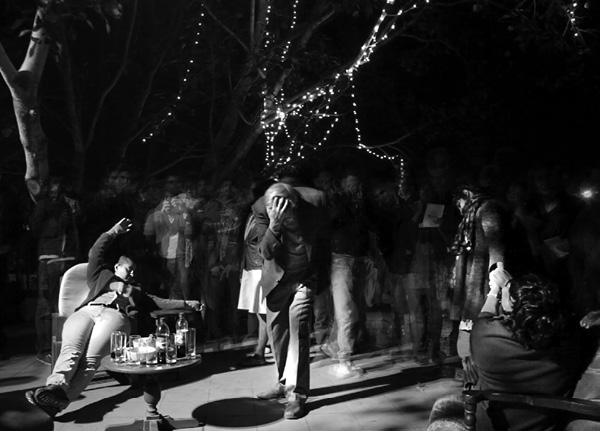
PAUSE TO RELEASE
first performed on January 27, 2012
KhojLive 12 at Blue Frog, Mehrauli, India
performed once in 2012
NEHA CHOKSI
Raaghav Chanana, Shaily Gupta, Amrita Lalljee, Jasbir Singh Malik, Keshav Moodliar, Anirudh Nair, Himali Singh Soin, Abhinandita Mathur, Vishal Rawlley, Sidharth Mathawan, Karan Leo Vohra
Mumbai, India / Los Angeles, CA
015762188s015762188t015762188u015762188d015762188i015762188o015762188@015762188n015762188e015762188h015762188a015762188c015762188h015762188o015762188k015762188s015762188i015762188.015762188c015762188o015762188m
nehachoksi.com
PAUSE TO RELEASE
NEHA CHOKSI
KhojLive is a performance festival hosted by Khoj, an organization known for events chock-full of simultaneous programming and an engaged art audience full of a society cocktail party spirit. When I first participated in KhojLive in 2008, I deviated from a normative pre-condition of performance, namely an active body. I chose to perform absence through a piece titled “Petting Zoo,” for which I anesthetized myself and four farm animals. This year, I determined to engage with the festival’s party atmosphere while maintaining ties to that earlier withdrawal.
“Pause to release” is a smaller self-contained party within the larger festival ambiance. Our intimate gathering abandons voice and motion to explore the presence of silence, allowing a partygoer to reflect on the ur-party itself. We express the eloquence of a gathering at a standstill—a still life infused with the eroticism of passing time and the impotence and heft of physical arrest. We are a frozen tableau of partying, in scenes of indeterminate engagement with the attendees of the larger public party.
The alert noted our presence and stood by to observe. The inattentive or distracted sometimes sat on our furniture, turning to talk to one of us until embarrassed awareness set in.
The tableau was enacted the moment right before or after typical “party moments.” The paradox operated twofold.
First, the quiet tableau were experientially the loudest, because the performers’ focus holds silence in unnatural tension with the implied action surrounding each frozen moment. The actors-on-break scenes are unobtrusively quiet, because focus relaxes. There is no history or future implied by these rests: only the performance work that was done and is imminent after the performed break.
Second, the performers behave as though they are in attendance rather than on stage; the audience has very little to attend to. The tensions between silence and action only acquire force within the understanding of each audience member, through a perception of the relation between the larger party and smaller party. Thus, this piece is performance—it is not theater, photography, or sculpture.
The work is a reflection of the KhojLive Party we are caught in, except it is more self-aware; it is a party that attends to the machine of art production and consumption. It is an occupation of the party with a counter-gathering, an anarchic refusal to participate in the Party.